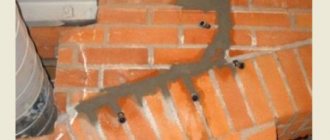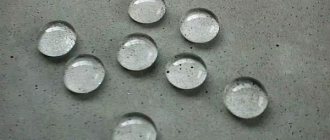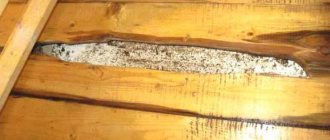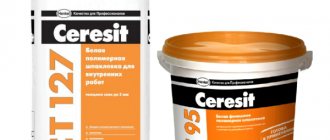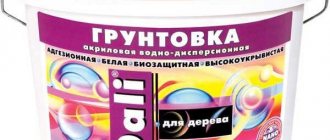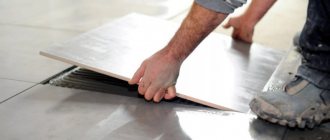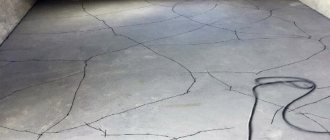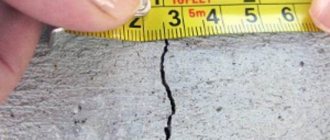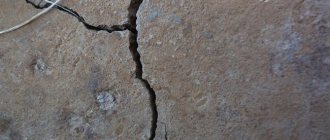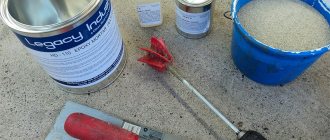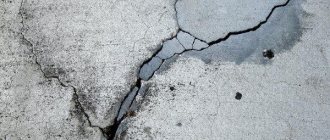Beton-House.com
Website about concrete: construction, characteristics, design. We combine the experience of professionals and private craftsmen in one place
Cracking is the main scourge of any concrete foundation.
Concrete surfaces have gained popularity due to their great strength, which is why concrete is used in many areas of construction. However, even such a durable material can crack and split if not properly maintained and other factors occur.
How to repair cracks in a concrete floor, and how to prevent their occurrence, let’s take a closer look at this pressing issue from all sides.
- Industrial method
- Sealing cracks with cement and lime
Why does concrete break down?
Even if the screed is installed correctly and all technological requirements are met, repairs to the foundation may still be required over time. But before repairing defects, it is very important to find out the exact cause of the destruction.
The main causes of deformation can be combined into several groups:
- Soil impact: soil rising during winter frosts due to ineffective heating of the room, poorly compacted bulk soil, subsidence of the entire structure and erosion by groundwater. During such impacts, the appearance of the concrete floor may remain attractive, but if even minor damage is detected, it is necessary to urgently take measures to eliminate it.
- Internal changes in the screed: the appearance of defects as a result of incorrect actions in the first few hours after pouring the concrete solution, shrinkage cracks and peeling of the upper layers of the solution from the base.
- External influences: destruction of the surface due to strong impacts on the floor covering and dusting of the surface as a result of long-term use.
If, after inspecting the ceilings, it was determined that the surface area of more than 35% was damaged, then partial repair of the surface is impossible. In this case, a complete repair of concrete surfaces in the premises is necessary.
Destroyed foundation
Use of injection mixtures
Injection dry mixtures can be used as the base material for deep cracks and depressions . They consist of fine Portland cement and special chemical additives.
This composition can be used to fill gaps, cavities, seams, and floor cracks larger than 0.4 mm. The consistency of the solution varies from highly fluid to plastic, which depends on the conditions of use and purpose.
Preparation
To obtain a highly fluid mixture, take 0.4 liters of water per 1 kg of dry mixture, 0.3 liters for a plastic-liquid mixture, and 0.25 liters for a plastic mixture. It is not recommended to mix more than 15 kg at a time.
Sequence of work:
- Mixing water is placed in a clean container. The volume of water is carefully measured;
- turn on a low-speed drill (500 rpm) and introduce about 2/3 of the mixture from the total consumption;
- the mass is mixed until smooth;
- the remainder is introduced and the mixture is again brought to homogeneity;
- The total kneading should last about 10 minutes.
Application
Before injection begins, the injectors are installed. The functionality of the mortar pump is first checked (take those that are designed to work with cement mortars). If required, a test injection with clean water is carried out. The defect is filled with solution.
The restored floor requires care: water spraying, covering with polyethylene film or damp burlap is necessary
Preparing the base
In order for the repaired screed to last for a long time, and the repair of concrete floors to go smoothly, this stage simply needs to be taken seriously. The algorithm of actions is as follows:
- First of all, the room is completely cleared of all objects.
- Then it is necessary to dry the base and at the same time ensure good ventilation of the room.
- Next, we proceed to remove the exfoliated pieces of the concrete floor, and then, after wetting, we remove the remaining small crumbs with a broom.
- Cracks and holes in the base must also be cleaned of debris using a construction vacuum cleaner.
- Traces of rust, old putty, mold are removed using a metal brush.
- If there is dirt on the floor in the form of grease stains, they can only be removed with special cleaning products purchased in the store. The use of kitchen detergents is strictly prohibited.
- Protruding reinforcement also needs to be cleaned and treated with a special compound.
Types of concrete floor repairs
Naturally, the first thing to do on the floor is to carry out a thorough inspection of its condition. The resulting picture and the conclusions drawn about the reasons for the “ill health” of the coating will help determine the choice of damage repair technology.
There are several types of repair work on concrete screed. Each of them is suitable for a specific case, that is, depending on the causes and extent of damage.
- Dust removal . They resort to it when the screed shows low surface strength and is very dusty. The dust removal process can be an independent and sufficient measure for floor repair (but not so often). Usually it becomes one of the preparatory stage operations for other, more complex repair cases.
- Local repair is the elimination of small defects that appear in the form of potholes, protrusions, sinkholes, cavities, deep and wide cracks that have arisen in individual areas;
- Major repairs of the floor for the installation of a decorative covering or a “warm floor” system are carried out if more than 30–35% of the area of the entire screed is damaged. There is no point in thinking about “fighting individual shortcomings” - everything needs to be redone, initially with high quality.
How to prepare a solution for concrete
To prepare the solution, you can purchase ready-made mixtures with trixotropic-rheological properties, but if you wish, you can make such a solution yourself.
A self-prepared solution is applicable in apartments where the screed is located on the floors in a relatively stable and static position. To mix a concrete solution, you will need to purchase Bustilat or PVA glue, dilute the purchased composition with water five times and mix it based on the resulting solution.
Also, if there is a large amount of work, it is advisable to immediately buy PVA putty. But such a suspension cannot repair deformation damage; for such work it is necessary to purchase specialized solutions in stores.
Since the finished batch must contain an absolute minimum of water, it is very difficult to do it manually. Therefore, for high-quality mixing of the mixture and uniform distribution of all components, it is necessary to use a drill with a special attachment for stirring the solution. This part can be purchased or made independently. For self-production, you will need an even rod with a diameter of 8 - 10 millimeters, which at one end is bent in any shape.
Drill with a nozzle for stirring the mixture
In addition, for the work you will need a trough or bucket for mixing the mixture, a rule (necessarily factory-made) and a wide spatula.
Restoration of expansion joints
The strength of concrete has been tested for years, but over time, during operation, problems begin with the seams of the concrete base. Damage to seals and the formation of destruction can be corrected as follows:
- widen the problem area of the seam using a diamond disc and trim off the sloppy edges;
- remove accumulated debris, dust and flaking areas;
- apply an epoxy primer to the inside of the seam;
- fill the seam with a solution of cement and polymer;
- Marks are placed to identify the seam using a special marker-rod along the length of the seam, a step of at least three meters is observed;
- after the special repair composition has hardened, the seams are sanded;
- the previously fixed marker-rods are taken out and a new expansion joint is cut in that place;
- the resulting dust is removed from the seam and sealed using silicone sealant.
Return to contents
Filling Potholes in Concrete
Such damage occurs during strong mechanical shocks or when operating equipment remains in one place for a long time. Therefore, repair of a concrete base in industrial and domestic premises with such defects looks like this:
- Using a tool, it is necessary to expand and deepen the damage. This is done to remove any remaining weakened areas of the concrete floor. Then you need to clean and prime the damaged area. And fill the damaged area with adhesive or epoxy mixture.
- Then treat the surface several times with a metal pin to remove possible air voids and better distribute the mixture. The horizontal line is leveled with a spatula. After complete drying, the repair area must be sanded.
- If the defects are more than four centimeters deep, then filling the potholes is carried out in several steps. This is necessary in order to prevent the formation of voids.
Video description
How to strengthen concrete that is peeling off from the base is described in the video:
Having found out why the floor screed cracked and what to do, you can begin repairs.
- First, by tapping, areas of delamination and voids are identified and marked with chalk.
- In the marked places, holes are drilled in the screed at a distance of 15-20 cm from each other.
- After cleaning and priming, an epoxy mixture is poured into the holes.
- It also seals cracks.
- After the mixture hardens, the holes are filled with liquid cement mortar.
It is important! This method cannot be used if a water or electric heated floor system is installed in the screed, or other communications without an accurate wiring diagram.
When drilling repair holes, there is a high risk of damaging the cable Source sense-life.com
Repairing cracks in concrete
This kind of damage to the concrete base occurs when the building shrinks, as well as the foundation. Thus, sealing cracks looks like this:
- Using a chisel and hammer or perforator, the crack is deepened and widened.
- Then the widened gap is cleared of pieces of concrete and dust. Next it is treated with a special primer.
- Then we fill the crack with mortar and level the surface with a spatula or rule.
- If the cleaned crack has a large width, then it is necessary to perform reinforcement; for this, cuts are made along the crack with a grinder, into which cut pieces of rod are placed. All cuts must also be concreted.
Repairing cracks in concrete
Dust removal
The essence of dust removal is treatment with special penetrating compounds.
With frequent, intensive use of concrete surfaces, increased dust formation occurs. Cement dust can greatly harm human health and compromise the integrity of the floor, which deteriorates over time. Such floor problems can only be corrected by repairing the base.
Dust removal can be ensured by applying coloring agents or a special composition to the surface, which is used to cover problem areas to reduce the formation of dust. The coloring composition impregnates the screed to a depth of half a centimeter and serves as a barrier to dust. The use of coloring materials creates the ability to withstand the effects of negative temperatures. Such compounds resist chemical compounds and increase the wear resistance of materials under various friction conditions. Repairing the floor in this way will not require large financial costs and physical effort. Painting the floor to prevent excessive dust formation is popular due to the ease of work and the possibility of doing it yourself.
Return to contents
Removing cobwebs
Such damage occurs during extremely rapid drying of the screed. Such a defect does not pose a threat, but over time it can develop into cracks, as a result, repairs will be inevitable. The solution is as follows:
- It is enough to treat such minor cracks with a primer or sealant. If weak areas are detected, the delamination must be cleaned.
- After cleaning and priming, the resulting niche is filled with solution and leveled.
Preparatory stage
The basic preparatory process for all methods is as follows. The first step is to dismantle the floor covering. It is advisable to dry the floor for a day or several days before carrying out repair work, and then carefully remove all debris.
Rust, mold and old primer are removed with a wire brush. Grease stains and paint are removed with chemicals. The better the surface is prepared, the better the repair will be done. If the reinforcement is “exposed,” it is cleaned and anti-corrosion treatment is carried out. The further repair process depends on the damage.
Local irregularities
Sometimes, during long-term use, part of the concrete floor sags, and also if the beacons were incorrectly positioned during the pouring of the screed, then waves are formed.
The algorithm for eliminating them is as follows:
- Waves can be leveled using a grinder with a trowel disc. During such an operation, be sure to use a respirator, as a lot of dust is generated. If you need to treat a large area of the room, then it is advisable to contact specialists or rent equipment.
- The depressions need to be cleaned and processed. Then you need to fill with self-leveling mixture.
Mixer and rule
Regardless of how cracks in concrete floors are repaired, almost all compositions require mixing. Homemade ones are mixed with PVA suspensions, while store-bought ones are mixed with water. It is almost impossible to stir the solution manually - given the fact that little water is added to it, the viscous mixture is difficult to handle manually: it will take a very long time to mix, during which there is a high probability that the solution will begin to set.
The solution must be mixed for 3-5 minutes before it can be used to seal the defect, performing circular movements with the tool (if the kneading is carried out in a bucket) or zigzag transverse movements (if in a trough). It is advisable to have a container with water nearby, since after kneading the mixer must be immediately rinsed thoroughly by immersing it in water and setting high speed.
To carry out floor repairs, you may also need a rule - this is a special tool, like a spatula, only about a meter wide. As a rule, it is better to buy a factory-made one so that the concrete does not “eat up” the rubbing part of the tool.
